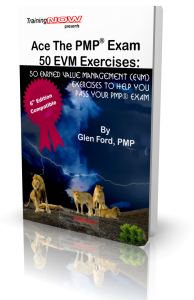Ace The PMP Exam: 50 EVM Exercises
Ace The PMP Exam 50 EVM Exercises:
50 Earned Value Management (EVM) exercises to help you pass your PMP exam (Volume 2)
by Glen Ford, BSc., MCPM, PMP
Do You Want To Pass Your PMP® Exam?
The Project Management Professional certification from PMI is one of the world’s premium certifications. It is trusted around the world. And there is a good reason. The exam is very, very difficult to pass.
Earned Value Management or EVM is a critical tool for project managers to know. And your ability to use it will be tested several times during the exam.
The problem is that most people don’t use the techniques in their working lives. They just don’t have the practice.
EVM isn’t hard to do. All it takes is practice. But getting the examples to practice on has been difficult. Until now!
This book contains 50 examples for you to work through. It guides you on a journey from simple to very complex. And it tests your ability to manipulate Earned Value Management calculations in multiple ways. By the time you finish this book, you’ll never worry about EVM again!
Kindle Edition: Coming Soon! $9.97 U.S.
available only from the Kindle Store
Print Edition: AVAILABLE NOW! $19.95 U.S.
available from Amazon.com or your local bookstore ISBN# 978-1543111194
Selected topics from
Table of Contents:
- A Note from the Author
- Chapter 1: Introduction
- Chapter 2: Earned Value Management
- The source numbers for EVM
- The hybrid values (the future amounts)
- The current state variances
- The performance indices
- Into the future (variances and required completion rates)
- Estimating completion
- The past is the future
- The variance was a one-time thing
- Budget is out but so is schedule
- Forget the budget we were smokin’
- Summary
- Chapter 3: The Exercises
- Question # 1: Calculate Variances & Indexes
- Question # 2: Calculate Variances & Indexes
- Question # 3: Calculate Variances & Indexes
- Question # 4: Calculate Variances, Indexes, and TCPI
- Question # 5: Calculate Variances, Indexes, and TCPI
- Question # 6: Calculate Variances, Indexes, TCPI, and EACs
- Question # 7: Calculate Variances, Indexes, TCPI, and EACs
- Question # 8: Calculate Variances, Indexes, TCPI, and EACs
- Question # 9: Calculate Variances, Indexes, TCPI, and EACs
- Question # 10: Calculate all with Given
- Question # 11: Calculate all with Given
- Question # 12: Calculate all with Given
- Question # 13: Calculate all with Given
- Question # 14: Calculate all with Given
- Question # 15: Calculate all with Given
- Question # 16: Text questions
- Question # 17: Text questions
- Question # 18: Text questions
- Question # 19: Text questions
- Question # 20: Text questions
- Question # 21: Text questions
- Question # 22: Text questions
- Question # 23: Text questions
- Question # 24: Text questions
- Question # 25: Text questions
- Question # 26: Text questions
- Question # 27: Text questions
- Question # 28: Text questions
- Question # 29: Text questions
- Question # 30: Text questions
- Question # 31: Extended calculation questions
- Question # 32: Extended calculation questions
- Question # 33: Extended calculation questions
- Question # 34: Extended calculation questions
- Question # 35: Extended calculation questions
- Question # 36: Extended calculation questions
- Question # 37: Extended calculation questions
- Question # 38: Extended calculation questions
- Question # 39: Extended calculation questions
- Question # 40: Extended calculation questions
- Question # 41: Interpretation questions
- Question # 42: Interpretation questions
- Question # 43: Interpretation questions
- Question # 44: Interpretation questions
- Question # 45: Interpretation questions
- Question # 46: Interpretation questions
- Question # 47: Interpretation questions
- Question # 48: Interpretation questions
- Question # 49: Interpretation questions
- Question # 50: Interpretation questions
- Chapter 4: A final note and an offer
Print Version


